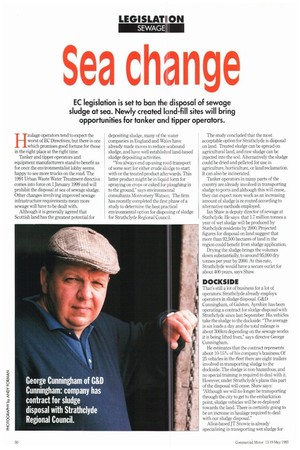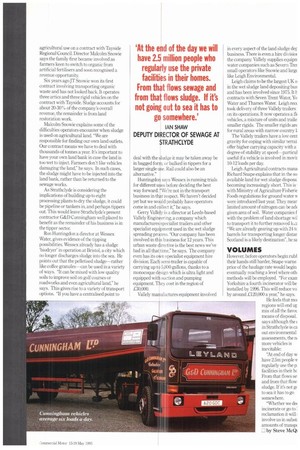Sea change
Page 52

Page 53

If you've noticed an error in this article please click here to report it so we can fix it.
Haulage operators tend to expect the worst of EC Directives, but there is one which promises good fortune for those in the right place at the right time.
Tanker and tipper operators and equipment manufacturers stand to benefit as for once the environmentalist lobby seems happy to see more trucks on the road. The 1991 Urban Waste Water Treatment directive comes into force on 1 January 1999 and will prohibit the disposal at sea of sewage sludge. Other changes involving improved sewage infrastructure requirements mean more sewage will have to be dealt with.
Although it is generally agreed that Scottish land has the greatest potential for depositing sludge, many of the water companies in England and Wales have already made moves to reduce seabound sludge, and have well established land-based sludge depositing activities, You always end up using road transport of some sort for either crude sludge to start with or the treated product afterwards. This latter product might be in liquid form for spraying on crops or caked for ploughing in to the ground," says environmental consultants Montomery Watson. The firm has recently completed the first phase of a study to determine the best practical environmental option for disposing of sludge for Strathclyde Regional Council. The study concluded that the most acceptable option for Strathclyde is disposal on land. Treated sludge can be spread on agricultural land, and raw sludge can be injected into the soil. Alternatively the sludge could be dried and pelleted for use in agriculture, horticulture, or land reclamation. It can also be incinerated.
Tanker operators in many parts of the country are already involved in transporting sludge to ports and although this will cease, they can expect more work as an increasing amount of sludge is re-routed according to alternative methods employed.
Ian Shaw is deputy director of sewage at Stathclyde. He says that 1.7 million tonnes a year of wet sludge will be produced by Stathclyde residents by 2000. Projected figures for disposal on land suggest that more than 92,500 hectares of land in the region could benefit from sludge application.
Drying the sludge brings the volumes down substantially, to around 95,000 dry tonnes per year by 2000. At this rate, Strathclyde would have a secure outlet for about 400 years, says Shaw,
DOCKSIDE
That's still a lot of business for a lot of operators. Strathclyde already employs operators in sludge disposal. G&D Cunningham, of Galston, Ayrshire has been operating a contract for sludge disposal with Strathclyde since last September. His vehicles take the sludge to the dockside: "The average is six loads a day and the total mileage is about 300km depending on the sewage works it is being lifted from," says director George Cunningham, He estimates that the contract represents about 10-15% of his company's business. Of 25 vehicles in the fleet there are eight trailers involved in transporting sludge to the dockside. The sludge is non-hazardous, and no special training is required to deal with it. However, under Strathclyde's plans this part of the disposal will cease. Shaw says: "Although we will no longer be transporting through the city to get to the embarkation point, sludge vehicles will be re-deployed towards the land. There is certainly going to be an increase in haulage required to deal with our sludge disposal."
Alloa-based JT Snowie is already specialising in transporting wet sludge for agricultural use on a contract with Tayside Regional Council. Director Malcolm Snowie says the family first became involved as farmers keen to switch to organic from artificial fertilisers and soon recognised a revenue opportunity.
Six years ago JT Snowie won its first contract involving transporting organic waste and has not looked back. It operates three artics and three rigid vehicles on the contract with Tayside. Sludge accounts for about 20-30% of the company's overall revenue, the remainder is from land restoration work.
Malcolm Snowie explains some of the difficulties operators encounter when sludge is used on agricultural land. "We are responsible for finding our own land outlets. Our contract means we have to deal with thousands of tonnes a year. Is important to have your own land bank in case the land is too wet to inject. Farmers don't like vehicles damaging the land," he says. In such cases, the sludge might have to be injected into the land bank, rather than be returned to the sewage works.
As Strathclyde is considering the implications of building up to eight processing plants to dry the sludge, it could be pipeline or tankers in, and perhaps tippers out. This would leave Strathclyde's present contractor G&D Cunningham well placed to benefit as the remainder of his business is in the tipper sector.
Ron Huntingdon a director at Wessex Water, gives evidence of the tipping possibilities. Wessex already has a sludge 'biodryer' in operation at Bristol, a city which no longer discharges sludge into the sea. He points out that the pellet ised sludge—rather like coffee granules—can be used in a variety of ways. "It can be mixed with low quality soils to improve soil on gulf courses or roadworks and even agricultural land," he says. This gives rise to a variety of transport options. "If you have a centralised point to deal with the sludge it may be taken away be in bagged form. or bulked in tippers for a larger single use. Rail could also be an alternative."
Huntingdon says Wessex is running trials for different uses before deciding the best way fonvard. Were not in the transport business in that respect. We haven't decided yet but we would probably have operators come in and collect it," he says.
Gerry Vallely is a director at Leeds-based Vallely Engineering, a company which manufactures specialist trailers and other specialist equipment used in the wet sludge spreading process. "Our company has been involved in this business for 12 years. This urban waste directive is the best news we've had in all that time," he says. The company even has its own specialist equipment hire division. Each semi-trailer is capable of carrying up to 5,800 gallons, thanks to a monocoque design which is ultra light and equipped with suction and pumping equipment. They cost in the region of £30,000.
Vallely manufactures equipment involved in every aspect of the land sludge der business. There is even a hire divisioi the company. Vallely supplies equipn water companies such as Severn Trei small operators like Snowie and largc like Leigh Environmental.
Leigh claims to be the largest UK o in the wet sludge land depositing bus and has been involved since 1975. It h contracts with Seven Trent Water, Yo Water and Thames Water. Leigh recc took delivery of three Vallely trailers on its operations. It now operates a fir vehicles, a mixture of units and trifle smaller rigids. The smaller rigids are f)trural areas with narrow country
The Vallely trailers have a low cent gravity for coping with similar terrai offer higher carrying capacity with a degree of stability at speed—particul useful if a vehicle is involved in movil 10-12 loads per day.
Leigh Agricultural contracts mana Richard Snape explains that in the so available land for wet sludge disposa: becoming increasingly short. This is • with Ministry of Agriculture Fisherie Foods regulations for ground water were introduced last year. They mear limited amount of nitrogen can be ad( given area of soil. Water companies f with the problem of land shortage wil to transport it to further removed k. "We are already gearing up with 24 tc barrels for transporting longer distar Scotland is a likely destination", he sa
However, before operators begin rubl their hands still harder, Snape warns price of the haulage rate would begin eventually reaching a level where oth methods will be employed. "For exan Yorkshire a fourth incinerator will be installed by 1996. This will reduce vu by around £120,000 a year," he says. He feels that mo.
regions will end ur mix of all the favoc means of disposal. says although the ( in Strathclyde is ca out environmental assessments, then' more vehicles is inevitable: "At end of day w have 2.5m people v regularly use the p: facilities in their lir From that flows se and from that flow sludge. If it's not gc to sea it has to go somewhere.
Whether we der incinerate or go to reclamation it will : involve us in subst amounts of transp( by Steve McCii
































































































































